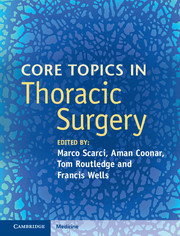Book contents
- Frontmatter
- Contents
- List of contributors
- Section I Diagnostic work-up of the thoracic surgery patient
- Section II Upper airway
- Section III Benign conditions of the lung
- Section IV Malignant conditions of the lung
- 11 Evaluation of solitary pulmonary nodule
- 12 Lung cancer staging
- 13 Pathological considerations in lung malignancy
- 14 Medical treatment of lung cancer (neo and adjuvant chemoradiotherapy)
- 15 Superior vena cava obstruction: etiology, clinical presentation and principles of treatment
- 16 Robotics in thoracic surgery
- 17 Pulmonary metastasectomy
- Section V Diseases of the pleura
- Section VI Diseases of the chest wall and diaphragm
- Section VII Disorders of the esophagus
- Section VIII Other topics
- Index
- References
15 - Superior vena cava obstruction: etiology, clinical presentation and principles of treatment
from Section IV - Malignant conditions of the lung
Published online by Cambridge University Press: 05 September 2016
- Frontmatter
- Contents
- List of contributors
- Section I Diagnostic work-up of the thoracic surgery patient
- Section II Upper airway
- Section III Benign conditions of the lung
- Section IV Malignant conditions of the lung
- 11 Evaluation of solitary pulmonary nodule
- 12 Lung cancer staging
- 13 Pathological considerations in lung malignancy
- 14 Medical treatment of lung cancer (neo and adjuvant chemoradiotherapy)
- 15 Superior vena cava obstruction: etiology, clinical presentation and principles of treatment
- 16 Robotics in thoracic surgery
- 17 Pulmonary metastasectomy
- Section V Diseases of the pleura
- Section VI Diseases of the chest wall and diaphragm
- Section VII Disorders of the esophagus
- Section VIII Other topics
- Index
- References
Summary
Superior vena cava (SVC) syndrome: definition
The symptoms resulting from compression or obstruction of the SVC system at any level, from the left and right brachiocephalic veins to the right atrium.
Historical notes
The SVC syndrome was first described in 1757 by William Hunter in a patient with a saccular aneurysm of the ascending aorta. At autopsy, “the superior vena cava and innominate vein were both so much compressed by the dilated artery as hardly to have anything left in the natural capacity and appearance”. Almost two hundred years later, Stokes, in 1837, described SVC syndrome related to a malignant tumor arising in the right lung; he observed that the underlying clinical findings were the result of the neoplastic compression on the vein and the progressive development of collateral circulation. Rosenblatt published in the early 1960s a review on lung cancer in the nineteenth century reporting several cases of SVC syndrome secondary to bronchogenic carcinoma.
Before the mid-twentieth century, only about one-third of the cases of SVC syndrome were related to malignant tumors; in fact, most were due to infections (syphilis causing aortic aneurysms or tuberculosis) or fibrotic mediastinitis. This etiological distribution remained stable up to 30–40 years ago, when 40% of the cases were still related to these diseases. From that time, improvement in treatment of granulomatous and infectious diseases and their prevention favored changes in the etiological distribution; nowadays, malignancy, in particular, lung cancer, has far overcome benign disorders as the primary cause of the syndrome.
This etiological shift from benign to malignant disorders consequently required a change in the therapeutic approach; surgical resection of the vessel en bloc with the tumor and subsequent reconstruction progressively became a viable therapeutic option. The first SVC bypass graft with an autologous superficial femoral vein was described in 1951 by Klassen and colleagues. However, complete sleeve resection and subsequent reconstruction of the SVC uniformly failed until the successful reconstruction by a spiral vein graft was described. Notwithstanding the progressive improvement of long-term patency rates, the complexity of this surgical technique prevented widespread acceptance. In 1987, Dartevelle and associates described the use of polytetrafluoroethylene (PTFE) grafts with proven patency in patients with neoplastic involvement of the SVC. Nowadays, excellent patency rates are achieved both with synthetic materials and with autologous and heterologous pericardium.
- Type
- Chapter
- Information
- Core Topics in Thoracic Surgery , pp. 150 - 157Publisher: Cambridge University PressPrint publication year: 2016



